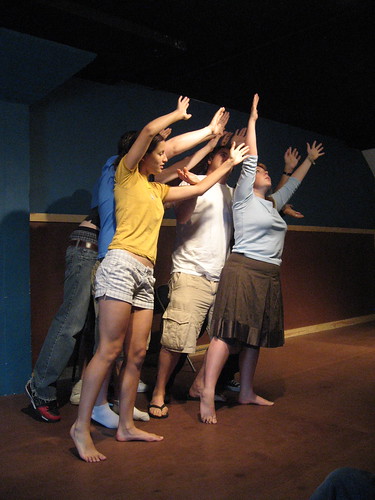
Day one of level four focused on creating three objects in the opening. What I forgot to mention was that we used those three objects to define the first three scenes of the Harold. It's a nice trick and feels really complete and relevant to the audience. We began day two with the idea that the three objects don't have to define the first three scenes. Instead they could define each beat in its entirety.
For much of the rest of the day, we toyed around with different styles of openings. How about an opening with no physical movement, just sound? Or one based on the players' sense of smell? Or a completely silent opening with nothing but physical movement to define each of the three objects?
Considering that the opening itself should go somewhere, we're always trying to build within the opening itself. What can we build on?
- WORDS. Repeating words or using similar-sounding words can help hold an opening together.
- THEMES. As I posted about day 1, if a strong theme starts coming out, we reinforce it (e.g. "filth" in the case of the toothbrush, car, desk)
- PHYSICALITY. Perhaps everything is low to the ground, or bouncing, or slithering, or jumping, or whirling, etc.
- NOISES. Are there strange sound effects that can be mirrored or complemented in the opening?
- PACING. Is this opening slow, fast, start-stop, rhythm-less?
VERY IMPORTANT: "Your second and third moves define everything in improv." - Wisdom from Pat
This is so true. Improv is a pattern-based art, and one move doesn't define a pattern. The second move picks a direction, but only the third move confirms it. I'd add that it's up to the fourth move to embrace what 1 through 3 have done.
Another thought from Pat: "Being on the same page doesn't mean doing exactly what others are doing. It means complementing them."
Here are some of the cool exercises we did:
- Get to Know Three People. I think we did this in the form of three monologues, but somebody might need to correct me on this one
- Paint Three Photos. Rather than describing three objects, we paint an actual scene captured by a still camera, three times.
- Define Three Scenes in One Town. Same idea, but we're narrowing the range of reality. One could be in a school, another in a market, a third in a courtroom.
(I have something in my notes about "tell a continuous story using themes in the scenes" but I can't remember exactly how we did this. Sorry folks. That's what happens when you wait a few weeks to document something.)
More stuff we did:
- Silent openings
- Reviewed two-person scenes, focusing on emotions and pacing
- Starting a scene with mandatory 30 seconds of silence, breaking the silence when one player says, "You are making me feel <insert emotion>." This was really powerful. We learned the gifts we can give each other with a simple emotional attribution
- Practiced shifting gears from the opening to scene 1
Two more cool words of wisdom from Pat:
"Playing fast doesn't mean talking fast. Taking it slow can be fast. It speeds up negotiation and agreement" in a scene.
"Support first and think later."
BOOya!
end of day two, level four.
